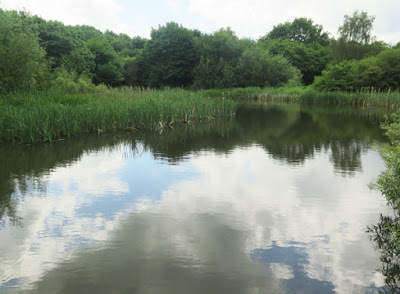 |
| A sculpture of a woolly mammoth |
At the bottom of Normanton Hill, beginning my exploration of the Shire Brook Valley, I carried on through Normanton Spring and stopped to take a few photos of the stone built vernacular architecture here – including Nether Wheel Row, a terrace of seven terraced houses built in the 1860’s by James Hutton for sickle grinders, but which were actually occupied by coal miners.
I had brought with me a few leaflets that I had picked up from the Shire Brook Valley Heritage Group stand at a recent Sheffield Heritage Fair that I had attended, which highlighted points of relating to the history and wildlife of the area.
Many of these were spread out along the upper reaches of the Shire Brook, which springs near Gleadless, and knowing that it would take much longer than a day to visit these, I just carried on past the roundabout on the A57, where Coisley Hill runs up an escarpment towards Woodhouse.
Turning down Stone Lane, which is named after a C16 quarry, of which I could find no signs, I made my way to the main entrance of the Shire Brook Valley Nature Reserve, which incorporates various reclaimed sewage works, Victorian rubbish tips and a modern landfill on the site of the former Birley East Colliery.
The Alan Bailey Visitor Centre was closed due to the COVID-19 Pandemic but, quickly walking around its exterior, I was very pleased to see that some reference to the geological sciences has been made by the inclusion of a sauropod dinosaur and a woolly mammoth in the timeline composed of steel sculptures, which runs around its exterior.
Using the maps in the leaflets, I then headed off to see if I could find some of the industrial archaeology listed in them and, crossing the brook, I had a quick look at its banks in a few places to see if it was likely that I might also find some rock outcrops there.
Although the stream bed is littered with various small pieces of sandstone and occasionally the sediment is iron stained, the banks are heavily overgrown and I didn’t think that it was worth spending the time to investigate further.
Moving up to Carr Forge Dam, I had hoped to see some engineering structures but, except for an inscribed marker stone, everywhere was again dominated by vegetation and I moved on to the path that runs through Linleybank Wood and went looking for the Rainbow Dam.
Finding only a graffiti covered and overgrown marker stone and a couple of blocks of unknown purpose, I carried on along the path and encountered a couple, who I speculatively asked if they knew the area well and if they were aware of any rock exposures to be seen in the road cuttings - which had been spectacularly exposed when the A57 Mosborough Parkway opened back in 1988.
To my surprise, I was informed that some of these were still to be seen along the section of the A57 to the east of the nature reserve and, following their directions, I headed off to find them.










No comments:
Post a Comment